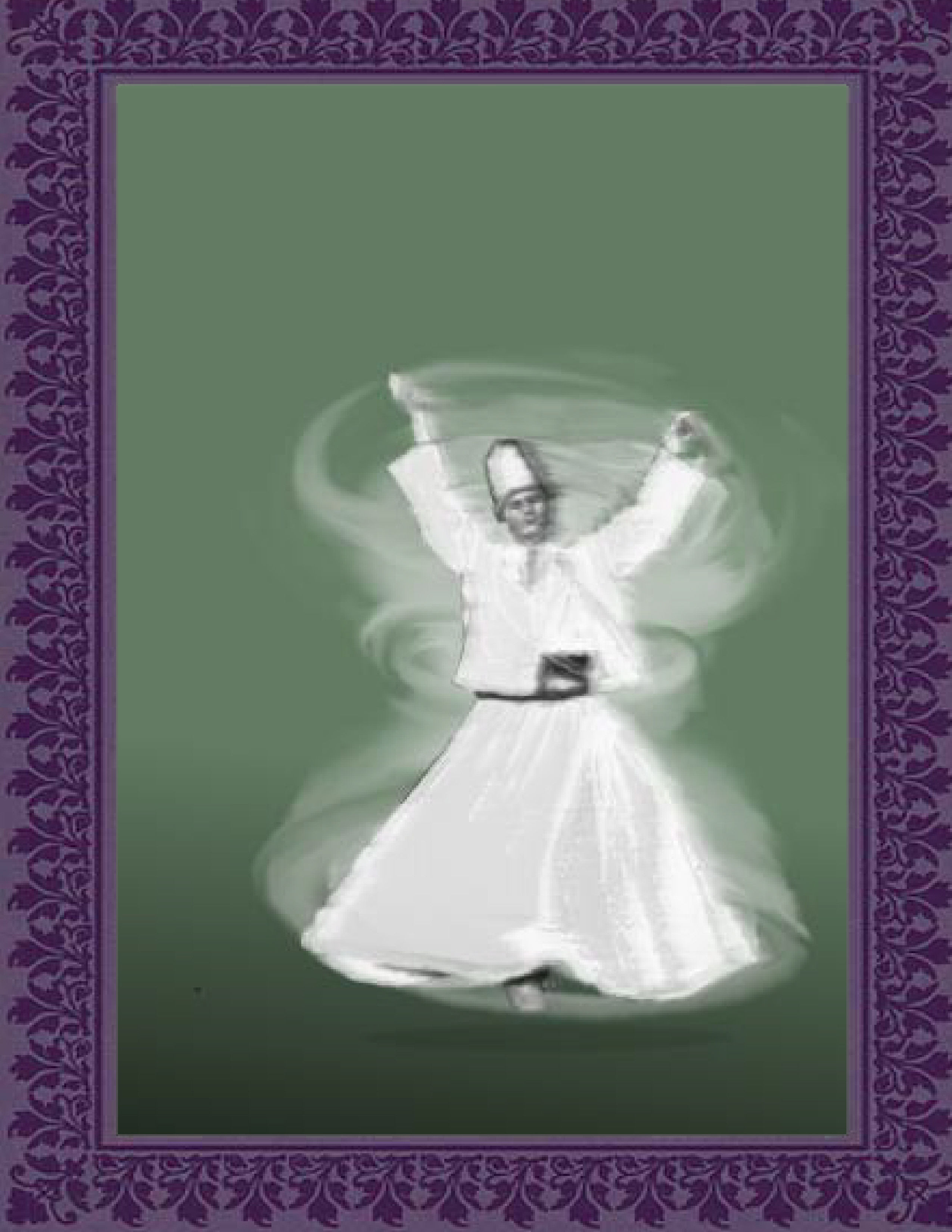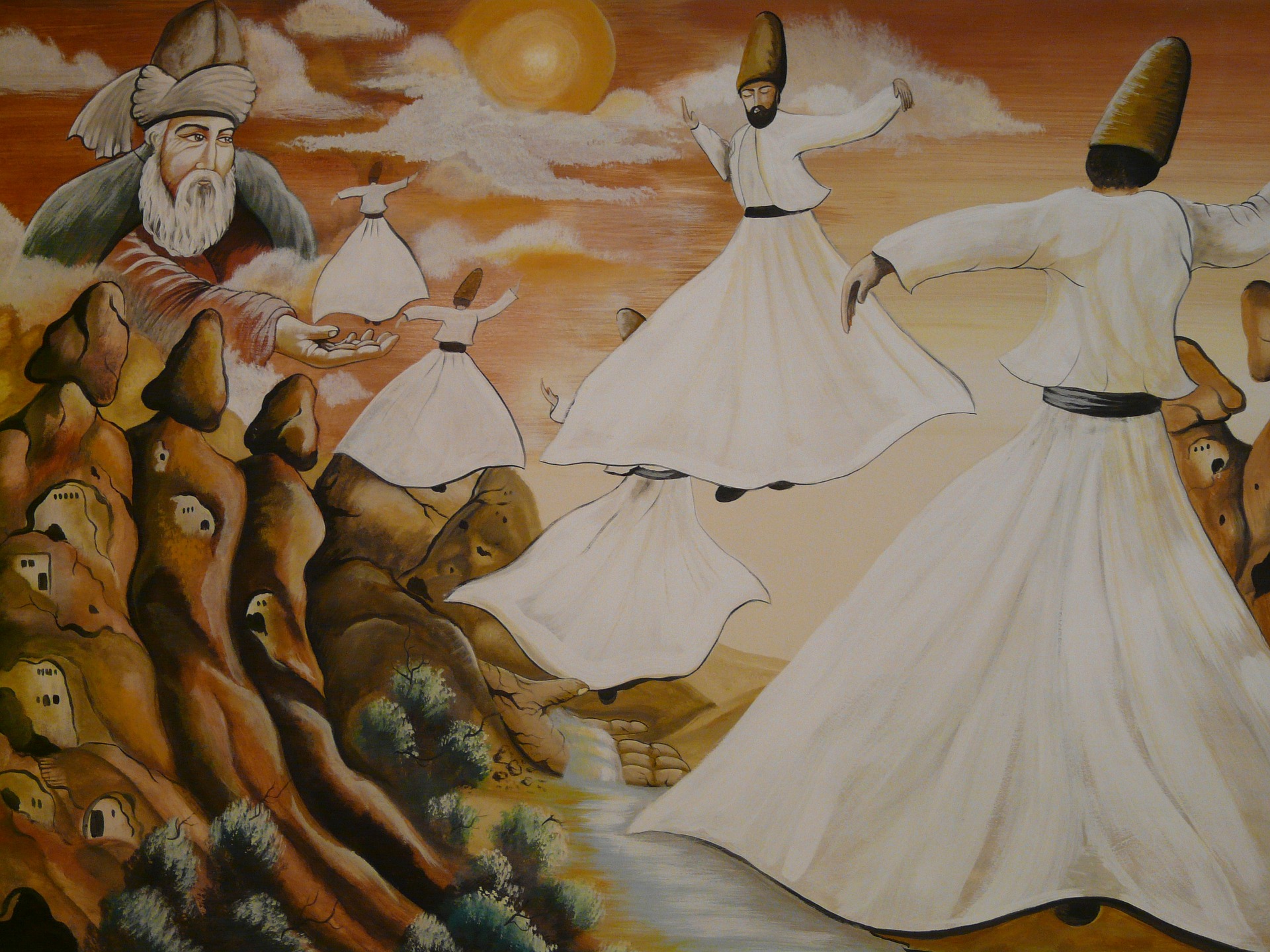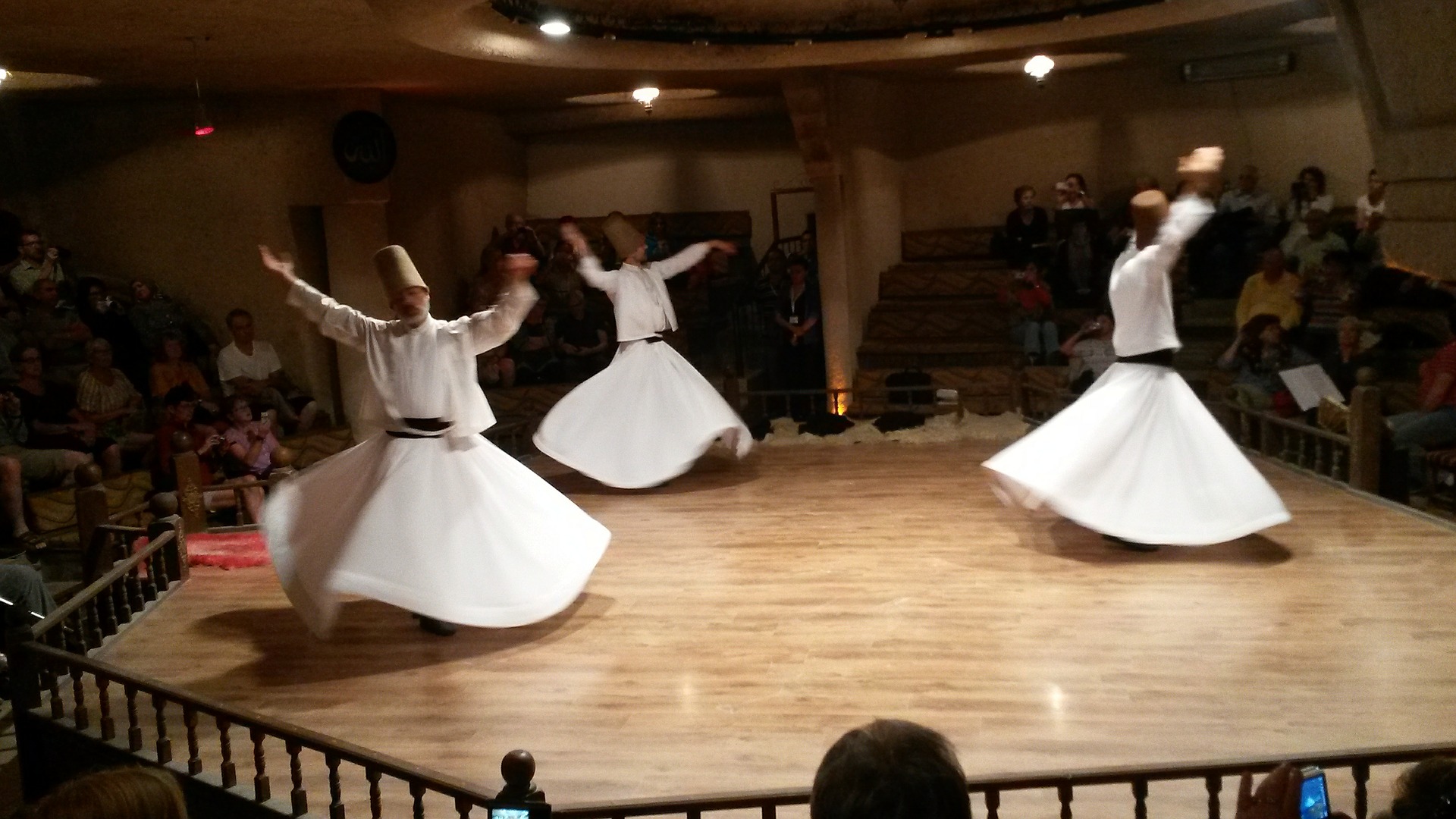 Submitted by Ali Rasha Bey on
Submitted by Ali Rasha Bey on

pixabay.com
Whirling dervishes perform a dance called the sema. It is a religious dance performed to express emotion and achieve the wisdom and love of God. It originated in Turkey, in the Islamic sect of Sufism, which was founded by Mevlana Jalaluddin Rumi. The Sufis support their knowledge from the Qur'an and the words of their master, Rumi. In order to become a dervish, young boys were required to attend schools called tekkes, where they would undergo an intense 1001-day retreat before they could perform the dance. The dervish considers himself an instrument of God so he cannot direct or retain the power that enters him. In 1925, the tekkes were closed and whirling ended until recently. Today semas are performed privately in homes or for the amusement of tourists.
The dance of the whirling dervishes, also known as the sema, originated in the 13th century near Turkey. It is performed by semazens (whirlers) that belong to the Mevlevi sect of the Sufi. Sufism is the Islamic practice of attempting to achieve divine knowledge and love though a personal relationship with God. It is said that the classification of Sufi comes from the wool cloaks they wore since in Arabic suf means wool. Others think that the title comes from the Greek work sophos, which means wisdom (Friedlander 15). Muslim priests in order to free their souls and connect with Allah perform the sema. The dance is sometimes interpreted as everything spinning around the sun but most commonly is thought of as a re-enactment of death and resurrection.

pixabay.com
The sema began from the influence of Turkish culture and the inspiration of Mevlana Jalaluddin Rumi. However, the practice of whirling may have originated in Central Asia long before Rumi where shamans used it to induce altered states of consciousness (Helminski). By performing the sema, Mevlevis try to experience the meaning of the words from the Qur'an: "To God belong the East and the West, and wherever you turn is the face of God. He is the All-Embracing, the All-Knowing" (Surah Baqara 2:115)
The scientific basis for the sema is the belief that "there is no being or object which does not revolve, because all beings are comprised of revolving electrons, protons, and neutrons in atoms. Everything revolves, and the human being lives by means of the revolution of these particles, by the revolution of the blood in his body, and by the revolution of the stages of his life, by his coming from the earth and returning to it" (Celebi).

pixabay.com
The semas practiced today occur in the following manner: first, the dervishes bow to the Sheikh. The hats that they wear, called sikkes, represent their own tombstones and are pulled tightly onto their head so that they don't fall off while the dervishes are spinning. Then there is the Sultan Veled Walk, where they trail the Sheikh around room while wearing black cloaks that symbolize their grave. Next, the dervishes let the cloaks fall off as they stretch out their arms to reveal their tennures (white robes). They begin to turn around their own axis while invoking the Name of Allah. As they spin, a reed pipe called a ney and drums are played in addition to chanting by the dervishes. It is believed that during the sema the power of Heaven enters into the dervish's upturned right palm, passes through the body, and leaves through the downward facing left palm into the Earth. The dervish considers himself an instrument of God so he cannot direct or retain the power that enters him.
Although no longer in existence, there were once several dervish schools called tekkes. Males under 18 were required to receive parental permission to enter a tekke. The boy would be guided by an older member of the tekke and would be initiated by the sheike. The boy would be given the choice between going on a 1001 day retreat and joining the Mevlevi order or becoming a muhip, which means that he does not go on retreat or live in the tekke but comes every day to be trained in the dervish practices. If the new initiate chose the retreat then he must complete several tests. For the first test, he is brought to the kitchen where he is to sit on his knees upon the sake (a sheepskin) for three days without sleep or speaking. He could only move 5 times a day to pray, to eat, and to go to the toilet. On the fourth day he is bathed and shaved and given a black dress to wear for the rest of the retreat as well as a prayer (zikr) to repeat while working. His days then consisted of learning to dance the sema, praying 5 times a day, repeating his zikr, and doing service. Once completing the 1001-day retreat, the initiate could then wear white garments and is a dede in the Mevlevi order. He could then chose to either stay in the tekke where he would be a teacher or live in the city where he could come back to the tekke only on Thursday nights when the sema was performed. Women were not allowed in the tekke unless they came to watch the sema on Thursdays so men that chose to live in the tekke could not marry. (Friedlander 107-109)
Mevlana Jalaluddin Rumi (1207-1273), a Sufi poet and mystic, established the dervish order of the Mevlevis and started the whirling dance of the sema. Rumi's life was changed the day he met a wandering dervish named Shams of Tabriz. Shams had a revelation to go to the Asia Minor where Rumi was studying in college. There are several different tales of their encounter but in all of them the meeting of Shams deeply influences the thoughts of Rumi. After sixteen months together, Shams went to Damascus to escape the attacks of Rumi's jealous disciples. Rumi sent his son to beg Shams to return to Konya but as soon as Shams came back he disappeared and was murdered. Rumi did not know that Shams had returned and had been killed so he searched Damascus for his missing friend. After Shams disappearance Rumi began the spiritual concert called the sema, which was "not only a religious ceremony, but also a spontaneous manifestation of emotions" (Vitray-Myerovitch 27).
After Rumi's death in 1273, the Mevlevis practiced prayer in a whirling manner fashioned by Rumi's son, Sultan Veled, based on the movements of his father. The practice remained virtually uninterrupted until the overthrow of the Ottoman Empire in 1924. In 1925, Kemal Ataturk passed Law 677 into the Turkish Republic that ended the whirling in tekkes. Military police entered the Mevlevi tekke in Uskudar on a Saturday in December and order it to close. The police stated that "performing dervish practices, holding meetings in the tekkes, the profession of tomb-keeping and the office of sheike and other dervish initiations were abolished and, as of the reading, against the law of the Republic" (Friedlander 111). In 1927, Kemal Ataturk opened the tomb of Rumi as a museum but said that Turkey is a modern country that had no time for dervish magic. In December 1953, the first authorized Mevlevi sema since the tekkes were closed occurred in Konya, Turkey. The amount of semas slowly increased over the years but was emphasized to be only for tourists and not to be a religious practice for the dervishes. Today the tekkes remain unopened but the dervishes still perform private semas in their homes and in Konya in December to honor their founder, Mevlana Jalaluddin Rumi (Friedlander 111-114).
It is said in the Ruba'iyat:
Oh daylight, rise! atoms are dancing
The souls, lost in ecstasy, are dancing
To your ear, I will tell you where the dance will take you.
All the atoms in the air and in the desert,
Let is be known, are like madmen.
Each atom, happy or miserable,
Is in love with the Sun of which we can say nothing. (Vitray-Meyerovitch 43)
It is from this that Rumi is said to have performed the cosmic dance. He said, "There are many roads which lead to God. I have chosen the one of dance and music" (Vitray-Meyerovitch 43). The spinning is also a spontaneous reaction to ones emotions, such as when Rumi's friend Sham disappeared he began to turn to express his despair. It is said that the spiritual concert is justified as a means to illuminate consciousness; the music is an awakening of the soul. In the Qur'an a pre-eternal pact made between God and Adam's race is mentioned (VII, 172), and it is this pact that the mystic Djonayd uses to explain the sema. When Djonayd was asked why sufis shake in ecstasy when listening to their music, he replied, "When God interrogated the genes in Adam's kidneys during the primordial pact, saying: 'Am I not your Lord?' a gentleness was implanted in the souls. When they hear music, this memory awakens and shakes them" (Vitray-Meyerovitch 52).

By Molavi - Masnavi Manavi Molavi, Public Domain, https://commons.wikimedia.org/w/index.php?curid=17260486
http://home.wlu.edu/~lubint/touchstone/2000/Dervish-Fischer.htm
I. Primary Sources
Celebi, Dr. Celalettin. "Sema, the Universal Movement" 2 November 2000
<http://www.mevlevi.com/society/sema2.html>
From this source I found a quote from the Qur'an that provides a basis for the sema. It also provided an explanation for the sema in nature.
Friedlander, Shems. The Whirling Dervishes, Albany: State University of New York Press, 1992
From here I found most of my information of the training of dervishes, the history of Sufism, and quotes from Rumi.
Vitray-Meyerovitch, Eva de. Rumi and Sufism, Sausalito, California: Post-Apollo Press, 1987
This provided the most information on the history of Rumi and his life and teachings. It also explains how Rumi began the sema. It has quotes from Rumi, Sham, and other religious writings such as the Qur'an.
II. Secondary Sources
Celebi, Dr. Celalettin. "Sema, the Universal Movement" 2 November 2000
<http://www.mevlevi.com/society/sema2.html>
Friedlander, Shems. The Whirling Dervishes, Albany: State University of New York Press, 1992
Helminski, Kabir. "The Gate of Secrets" 2 November 2000. <http://www.mevlevi.com/society/sema2.html>
This source provides a bit of history on whirling and on Sham.
Shah, Idries. The Sufis, London: The Octagon Press, 1977
This source provided history of the Sufi's and the words of Rumi.
Vitray-Meyerovitch, Eva de. Rumi and Sufism, Sausalito, California: Post-Apollo Press, 1987
- 2067 reads